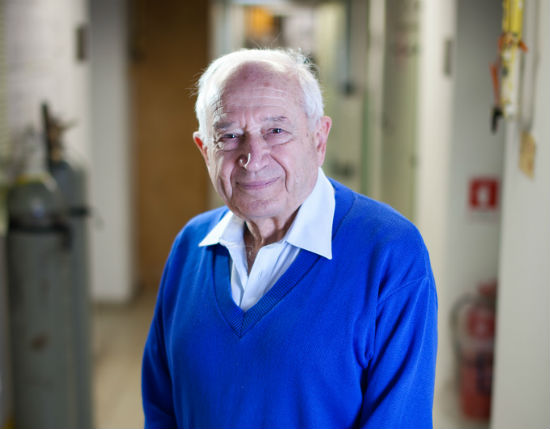
Professor Mechoulam… “Incense: Religious Viagra to TRPV3 Activator”

TheAnswerPage.com blog post by Professor Raphael Mechoulam, PhD
Faculty of Medicine, The Hebrew University of Jerusalem, Member, Israel Academy of Science
Incense burning was a central ceremony in the religious and cultural life of many – probably most or even all – ancient tribes and nations in the Middle East. In ancient Egypt incense burning signified a manifestation of the presence of the gods and a gratification to them. The ancient Greeks used incense burning as an offering to God, an oblation. In ancient Judea it was a central ceremony in the Temple. In Christendom its use in worship has continued since the 4th or 5th century C.E. However, it may have had also non- religious use. The famous Greek historian Herodotus (ca 450 B.C.) writes that “Whenever a man of Babylon has intercourse with his wife, he sits before an offering of incense, and the woman sits opposite him…” Was it an early Viagra?
A major ingredient in Middle Eastern incense is the resin of the Boswellia plant (known as frankincense, olibanum). In the ancient world Boswellia resin was considered a highly precious commodity, carried in caravans from sub-Sahara regions, where it is still a major export product. The Roman authority on scientific matters, Pliny the Elder (1st century C.E.), writes that only 3000 families of the Sabei tribe beheld the sacred trees, which produced the resin and while pruning the trees or gathering the resin, men were not to be ‘polluted’ by sexual intercourse or contact with a corpse.
The psychoactivity of Boswellia was recognized in ancient times. The Greek physician Dioscorides (1st century C.E.), whose book on medicinal plants was the leading text in pharmacology for many centuries, writes that it causes madness. In the Jewish Talmud (300-600 C.E.) Boswellia resin is mentioned as a potion (in wine) given to prisoners condemned to death to ‘benumb the senses’ or so that “he (the condemned) will not worry”. Indeed, some scholars suggest that the drink offered to Jesus on his way to Golgotha was wine with frankincense. In Abysinia Boswellia resin is still used as an antianxiety drug.
The use of Boswellia for its psychoactive properties extends beyond the Near East and Europe. In Ayurveda, an Indian medical tradition, it is reported to have a ‘strong action on the nervous system’. Surprisingly, in spite of the information stemming from the ancient texts, and present use in local traditions, the constituents of Boswellia had not so far been investigated for their psychoactivity. Apparently most present-day worshippers assume that incense burning has only a symbolic meaning.
We found that incensole acetate, a Boswellia resin constituent, when tested in mice lowers anxiety and causes antidepressive-like behavior. The assays employed were standard tests, used by many academic groups and industrial firms, for evaluation of drugs for these activities
To investigate the action of incensole acetate on different brain regions we studied its effect on c-Fos formation in mice brains 60 min after administration of the drug. c-Fos is a protein formed during changes in brain function. We found that, indeed, incensole acetate significantly changed c-Fos levels in brain areas known to be involved in the expression of emotions and in nerve circuits that are engaged by drugs that affect anxiety.
What is the mechanism in the body which causes these effects? We noted that incensole acetate does not bind to, and therefore does not affect, a large number of known receptors, through which mammalian biological systems cause changes in body functions. However, we found that it activates a receptor (known as ion channel TRPV3) which is implicated in the perception of warmth in the skin. It seems reasonable to assume that this effect may contribute to the spiritual exaltation associated with religious ceremonies, particularly on the conductors of the ceremonies, who presumably inhale large amounts of smoke. The ion channel TRPV3 is also found in the brain, but its functions there are unknown. Again, it seems reasonable to assume that, in view of our results, TRPV3 channels in the brain play a role in emotional regulation, possibly in anxiety and depression. Strong support to these assumptions was our observation that the effects of incensole acetate were not noted in mice in which (by genetic manipulation) the TRPV3 channels had been eliminated.
However, until the effects of incensole acetate have been confirmed in humans, we should remain cautious as to its effects.
We believe that our work on the biochemical and pharmacological effects of incensole acetate may be of importance in 3 directions:
- It provides a biological basis for deeply rooted cultural and religious traditions.
- The effects observed with a novel-type drug may open an alternative route to therapeutic agents in anxiety and depression, two major disorders found in large number of people. Although drugs are available for both conditions not all patients are well treated and novel drugs in both conditions are badly needed.
- The observation that the TRPV3 receptor in the brain is involved in emotional regulation may lead to novel neurochemical insights. Research over decades on plants eliciting psychoactive effects, such as Cannabis sativa (yielding marijuana), Papaver species (the source of morphine) and Nicotiana tabacum (the tobacco plant) has provided important insights into neurochemical processes and diseases of the central nervous system (CNS).
References:
- A.Moussaieff, E.Lev, Z.Amar, E.Fride, D.Steinberg, R.Gallily, R. Mechoulam. The Jerusalem balsam: from the Franciscan Monastery in the Old City of Jerusalem to Martindale 33. Ethnopharmacology, 101, 16-26 (2005).
- Moussaieff, E. Shohami, Y. Kashman, E. Fride, M. Lienhard Schmitz, F. Renner, B. L. Fiebich, E. Munoz, Y. Ben-Neriah, R. Mechoulam. Incensole acetate, isolated from Boswellia resin, inhibits nuclear factor NFĸB activation. Mol Pharmacol. 72, 1657-1664 (2007).
- Moussaieff, N.A. Shein, J.Tsenter, S. Grigoriadis, C. Simeonidou, A.G.Alexandrovich, V. Trembovler, Y. Ben-Neriah, M.L. Schmitz, B.L. Fiebich, E. Munoz, R. Mechoulam, E. Shohami. Incensole acetate: a novel neuroprotective agent isolated from Boswellia carterii. J Cereb Blood Flow Metab. 28, 1341-1352 (2008).
- A.Moussaieff , N. Rimmerman, T. Bregman, A. Straiker, C. C. Felder, S. Shoham, Y. Kashman, S. M. Huang, H. Lee, E. Shohami, K.Mackie, M. J. Caterina, J. M.Walker, E. Fride and R. Mechoulam. Incensole acetate, an incense component, elicits psychoactivity by activating TRPV3 channels in the brain. FASEB J. 22, 3024-3034 (2008).
- Moussaieff, R. Mechoulam. Boswellia resin: from religious ceremonies to medical uses: a review of in vitro, in vivo and clinical trials. J. Pharmacy & Pharmacol. 61, 1281-1293 (2009).


